Plastics to poo: ocean pollution lowdown
Naked Oceans goes from plastics to poo this month, as we get the low down on ocean pollution and find out how the stuff we dump into the seas causes all sorts of problems for the things that live there.
In this episode
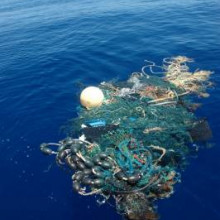
01:10 - Can you walk on the Pacific garbage patch?
Can you walk on the Pacific garbage patch?
with Miriam Goldstein and Rebecca Asch, Scripps Institute of Oceanography
Can you walk out on the Pacific garbage patch? And what's the problem if fish eat plastic? Miriam Goldstein and Rebecca Asch from the Scripps Institution of Oceanography explain why plastics are such a problem in the oceans, and the results of the SEAPLEX mission to find out what effects it might be having on wildlife.
Helen - Sadly, plastic debris like discarded buckets, garbage bags and fishing nets have become all too common sights on many of the world's beaches. But this small amount of visible coastal rubbish is just the tip of the iceberg of the waste found out in the open ocean, that most of us never get to see...
Miriam - There's actually areas of the ocean where there's more plastic than other areas of the ocean and those are the subtropical gyres. So people might have heard of the Pacific Garbage Patch or the Atlantic Garbage Patch and those exist because those are natural areas where currents come together.
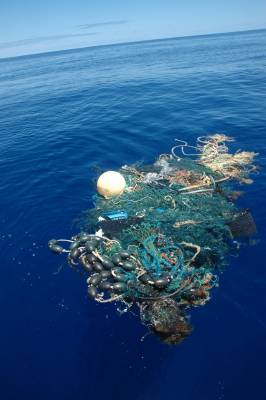 Helen - That was Miriam Goldstein from Scripps Institution of Oceanography, who was involved in a student-led project called SEAPLEX, the Scripps Environmental Accumulation of Plastic Expedition to go out and study the reality of this Pacific garbage patch. How much plastic was out there? And what impact was it having on wildlife? In terms of the volume of plastic, what the researchers saw shocked them...
Helen - That was Miriam Goldstein from Scripps Institution of Oceanography, who was involved in a student-led project called SEAPLEX, the Scripps Environmental Accumulation of Plastic Expedition to go out and study the reality of this Pacific garbage patch. How much plastic was out there? And what impact was it having on wildlife? In terms of the volume of plastic, what the researchers saw shocked them...
Miriam - The main surprise that we saw that there's just so much of this little plastic crumbs out there. So when you look at the ocean it actually just looks totally normal. It's a really nice blue colour, it's pretty, it's water, it's very pleasant to be out there, the sunsets are nice. And it's only when you start looking more closely that you see all the trash.
So you'll see objects floating by the boat every couple of minutes, like buckets or pieces of net, and then when you put a very fine meshed net in the water that catches things that are only a third of a mm, so that is the width of your fingernail or so, then you see these thousands upon millions of tiny particles. So you can see here in this jar, these larger pieces of plastic that are a couple of inches or a couple of cm, and then they're mostly just unrecognisable crumbs. There's no way of telling what the objects once were.
And if you look at the bottom of the jar, underneath the big pieces, you can see how small they get. They're just very very tiny crumbs that almost look like sand.
The reason that these are so small is that plastic become brittle under UV light as the plasticisers leach out - the chemicals that make it flexible - and those are substances you might have heard of like BPA or phenols. They leach out and the plastic becomes brittle and then it's moved around by the waves and comes into these tiny crumbs.
So one lost object can make lots and lots of microscopic crumbs of plastic.
We found that we really didn't have to do statistics. Things in the ocean aren't everywhere. Sometimes you find a lot of one thing and you can't find any of the other thing, but the plastic is everywhere. And that's what really surprised us.
Helen - So, while it may not be a case of being able to go walking and pitch a tent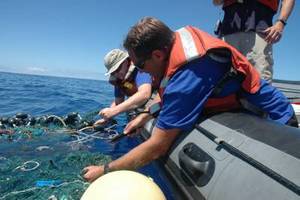 out there on the Pacific garbage patch, as some people have suggested, plastics are ubiquitous in the oceans. And if they're so ubiquitous, it follows that there must be some interaction with wildlife. But our knowledge of plastic waste impact is fairly limited...
out there on the Pacific garbage patch, as some people have suggested, plastics are ubiquitous in the oceans. And if they're so ubiquitous, it follows that there must be some interaction with wildlife. But our knowledge of plastic waste impact is fairly limited...
Miriam - The animals that we know about mostly are the ones that are larger and come to shore. We know for example that albatrosses eat it and they feed it to their chicks. We know that because they nest on shore. We know that sea turtles eat it and sometimes die from intestinal blockages. Again we know that because people notice when sea turtles die and also they come to shore.
But for the animals that spend their whole life in the ocean particularly the small ones we don't know very much at all.
Helen - So that was a major aim of the SEAPLEX project...
Miriam - we were trying to figure out how plastic was interacting with the little animals at the bottom of the food chain. So we were collecting water samples for bacteria and for phytoplankton, the microscopic plants, net samples for zooplankton which is the very small and sometimes microscopic animals, big nets or relatively big nets for the small fish. And then we also had observers onboard looking at sea birds and cetaceans, or marine mammals. As well as visually counting trash.
And it's data from the small midwater fish that has shown plastic waste is harming the wildlife out at these gyres...
Rebecca - We basically collected these fish using a variety of different types of net trawls and brought them back here and dissected them to see if they had ingested any plastic. And our main finding was that we did find plastic at about 9% of these fish.
Helen - Rebecca Asch there, who looked at the ingestion of plastics of these small fish along with colleague Pete Davison. Now, finding plastics in the stomachs of 9% of the fish they caught may not sound like a lot, but...
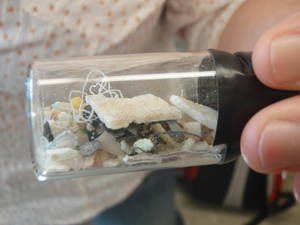 Rebecca - first of all I'd like to say that the number that we should be getting is zero because plastic isn't a natural food for these organisms.
Rebecca - first of all I'd like to say that the number that we should be getting is zero because plastic isn't a natural food for these organisms.
And Rebecca admitted that this 9% figure could be an underestimate as a result of them only being able to sample the plastic present in the stomachs of live caught fish. If the plastic had passed through their systems, or indeed caused fish to die after ingesting it, this wouldn't have been included in their data. But even with these results, when extrapolated, they provide some worrying numbers...
Rebecca - we did some calculations on given the number of fish that we caught and given the size of the area where you have plastic and how many fish there are in this area we conducted and extrapolation and what it came out to was that I believe it was 12-24,000 tonnes of plastic ingested by these fish per year.
Helen - This is made more worrying as one area of concern with ingesting plastics is that they act as a sponge for chemical pollutants like PCBs, which are harmful to wildlife.
Miriam - the worst part about them is that they bioaccumulate so that they get stuck in organisms fat and so they build up to very high levels in the predatory animals like seabirds and whales and so forth. But it is a matter of concern whether eating these plastic particles transfers a huge load of chemicals into these organisms. People are working on that right now.
And a possible next step could be to look at plastic ingestion and bioaccumulation of these pollutants further up the food chain.
Helen - But is there anything the public can do to help?
Miriam - the main thing about this issue is to stop putting trash into the ocean. 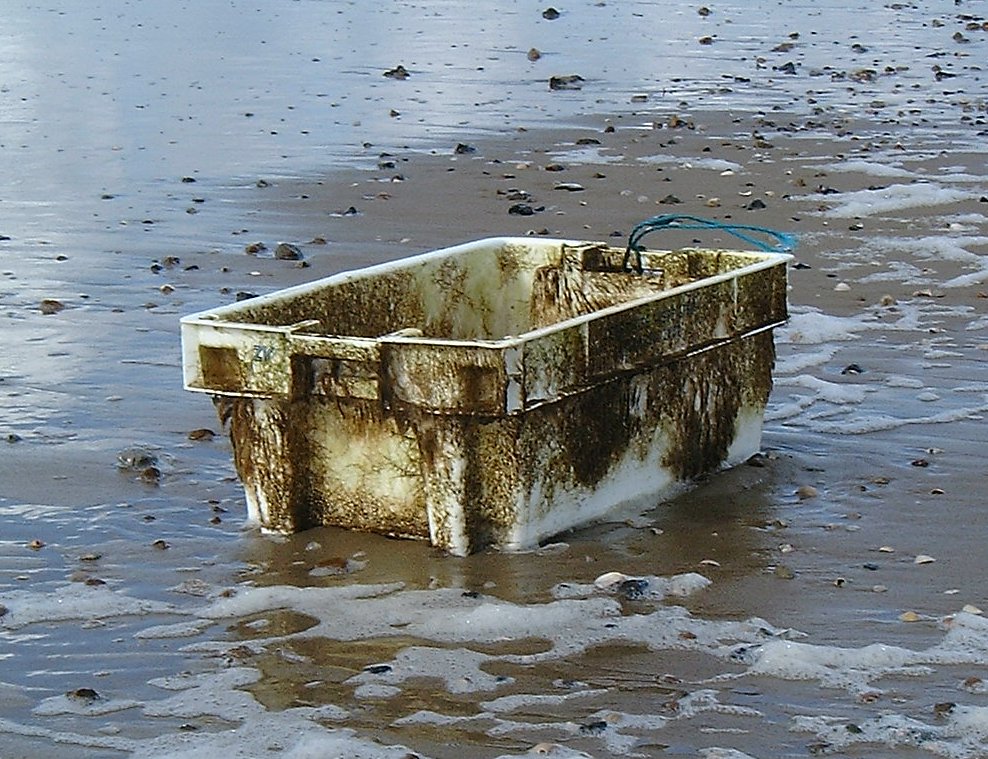 And that sounds really obvious but actually we're really bad about that. Here in Southern California we have a Mediterranean climate which means that it only rains in the winter. We throw trash into the canyons all year round and then as soon as it rains all that trash from months and months just gushes right on into the ocean and eventually goes in fact to the garbage patch, probably.
And that sounds really obvious but actually we're really bad about that. Here in Southern California we have a Mediterranean climate which means that it only rains in the winter. We throw trash into the canyons all year round and then as soon as it rains all that trash from months and months just gushes right on into the ocean and eventually goes in fact to the garbage patch, probably.
So by disposing of your own trash properly and by helping to dispose of trash that was perhaps not yours but is headed to the ocean and participating in beach clean ups everyone can help.
So, to help reduce the plastic waste problem we should try to help clean up our local beaches, and be careful how we dispose of our rubbish.
Find out more:
SEAPLEX
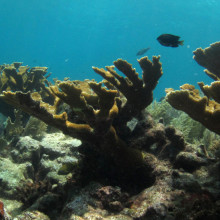
08:03 - Corals catch disease from human sewage
Corals catch disease from human sewage
with Kathryn Sutherland, Rollins College
Across the globe there are known to be around twenty types of disease that affect coral reefs.
Kathryn - Coral diseases are a major stressor affecting coral reefs today.
Helen - That's Kathryn Sutherland from Rollins College in Florida, a microbiologist and ecologist who specialises in coral diseases.
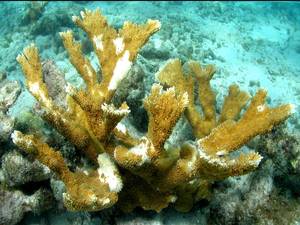 Kathryn - Since the mid 1990s we've seen & described an increasing number of coral diseases. And they are in combination with other stressors that affect coral reefs. Coral reefs are threatened by warming seawater temperatures and poor water quality and increasing population densities especially along coastlines, and climate change - all of these combine and lead to the decline of coral reefs
Kathryn - Since the mid 1990s we've seen & described an increasing number of coral diseases. And they are in combination with other stressors that affect coral reefs. Coral reefs are threatened by warming seawater temperatures and poor water quality and increasing population densities especially along coastlines, and climate change - all of these combine and lead to the decline of coral reefs
Helen - One particular disease that's having a devastating impact on corals in the Caribbean is called White Pox disease. It only affects Acropora palmata, otherwise known as elkhorn coral because it grows into large antler-like structures. The disease gets its name from the white blotchy patches left behind when areas of diseased coral tissue die off, and for elkhorn coral this has spelt very bad news indeed
Kathryn - Elkhorn coral was once the most common coral in the Caribbean. But in 2006 it was listed as a threatened species under the US Endangered Species Act. And white pox disease played a major role in the listing. Since the discovery of white pox disease in the mid 1990s, elkhorn coral has decline and average of 90% in the Florida Keys. And this decimation is occurring in combination with white pox disease and other disease and other stressors and these other stressors include elevated sea water temperatures, poor water quality and other diseases like white band that have led to the decimation of elkhorn populations Caribbean-wide '
Helen - Back when white pox first started spreading around the Caribbean, the cause of the disease was a complete mystery. And Kathryn Sutherland took on the task of figuring out what was going on.
Kathryn - We had no idea what was causing this new, emerging coral disease. And so I approached it from a viewpoint of it could be anything. It could be bacteria, it could be a virus, it could be a protist, it could be a fungus. And so I started my search and originally I actually thought it might be a virus because white pox disease only affects one species of coral as far as we know and viruses are known to be very host specific.
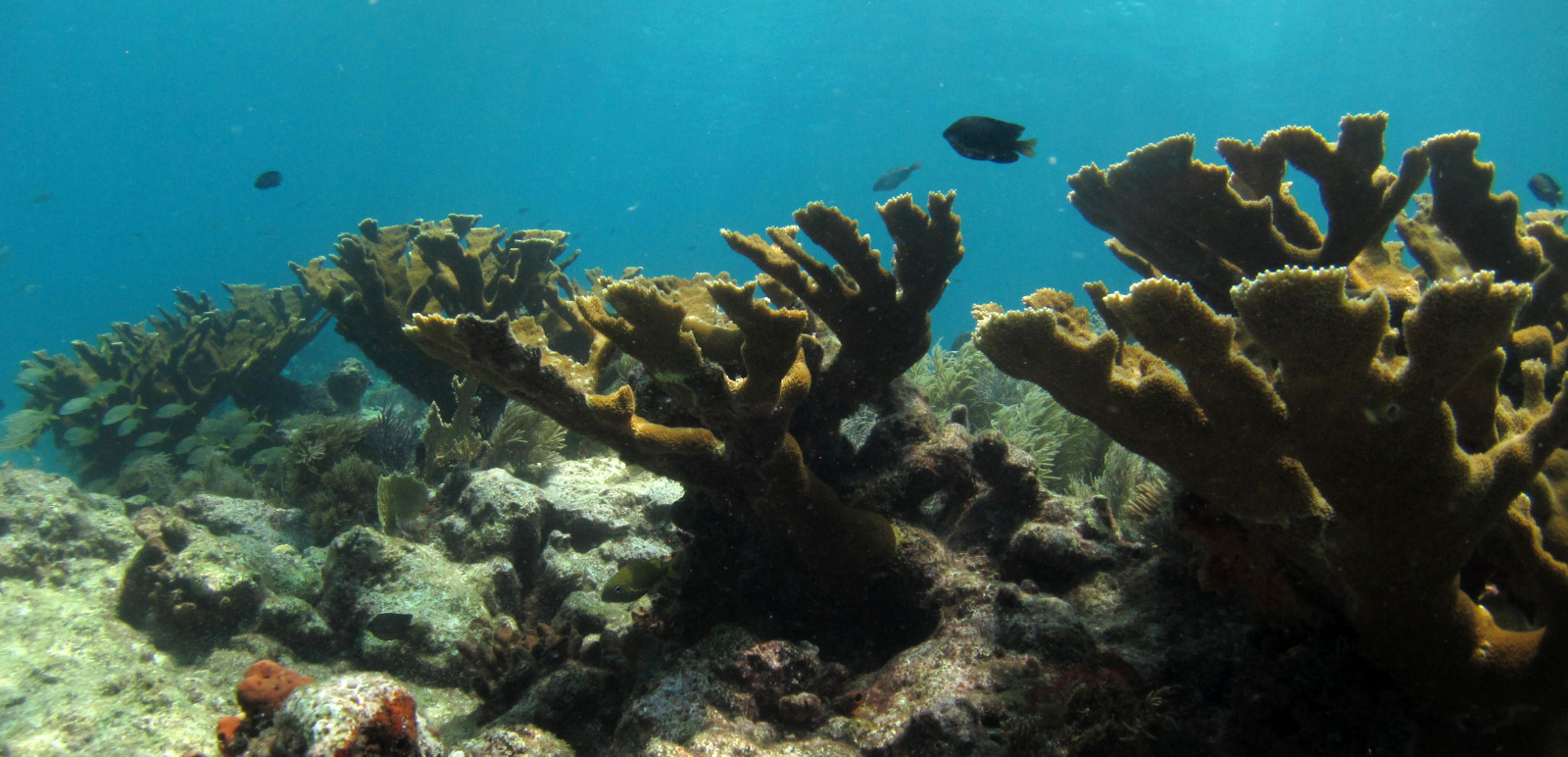 Helen - The focus for disease research in corals is the layer of sticky mucous that the coral polyps secrete onto their surfaces and Kathryn started out by investigating the bacteria that live in that surface layer.
Helen - The focus for disease research in corals is the layer of sticky mucous that the coral polyps secrete onto their surfaces and Kathryn started out by investigating the bacteria that live in that surface layer.
Kathryn - The mucous layer of a coral is the first line of defense of a coral against disease. And the mucous layer is full of microbes, whether or not the coral is healthy or diseased. And when we're looking for a disease pathogen we sample this mucous layer using non-destructive techniques, using a sterile needleless syringe, then we plate that mucous onto bacterial medias. And we can look for bacteria - we're going to find a lot because the microbes in healthy and diseased corals.
And for case for white pox I plated all the microbes that I found, plated them to pure culture and then I compared those that were found only in diseased individuals to those found in healthy individuals. And I had some potential culprits for pathogens for those that were clustering with the disease samples only. And then the next steps was to inoculate healthy elkhorn coral in a controlled seawater aquaria setting, so you're not affecting the population outside on the reef, and to see if those pathogens cause disease. And it turned out that the cause of white pox disease was indeed a bacterium.
And when we first discovered the pathogen that causes white pox disease in 2002, we knew that the bacteria that causes the disease, it's called Serratia marcescens, we knew that this bacteria was common in terrestrial environments, and in human guts and human sewage. But at that time we could only speculate that human sewage might indeed by the source of this pathogen that's killing corals because the pathogen, the bacterium, is actually found in the waste of other animals as well.
Helen - So, the next big question is where is this disease-causing bacteria, Serratia marcescens coming from? To work that out, Kathryn turned to genetic studies.
Kathryn - Once I'd identified the pathogen as Serratia marcescens in 2002 and wasn't certain where it was coming from, I did a widespread source survey looking at multiple potential sources in the Florida Keys. IN ordered to do this I collected human samples from the Key West wastewater treatment plant as well as waste samples from other animals like Key deer and sea birds. And I plated these samples on microbial media that was specific to the coral pathogen, Serratia marcescens.
And while I found Serratia marcescens in multiple animals, including key deer and sea guls, my genetic analyses showed that only the strain from human sewage matched the strain that was found in diseased corals on the reef. And so this gave me a genetic connection between the contamination of nearshore waters with sewage and the white pox disease of corals.
And then in order to indeed show that that strain of the pathogen from humans was causing the disease I inoculated healthy fragments again, like my original studies, with this strain that I found in human sewage and diseased elkhorn coral to see if it would be pathogenic. And indeed it was. The strain causes the disease in elkhorn coral in 5 days. So that gave us definitive evidence that humans and human sewage are the source of the pathogen that causes the devastating disease of corals known as white pox.
Helen - Kathryn and her team had traced the source of white pox disease back to 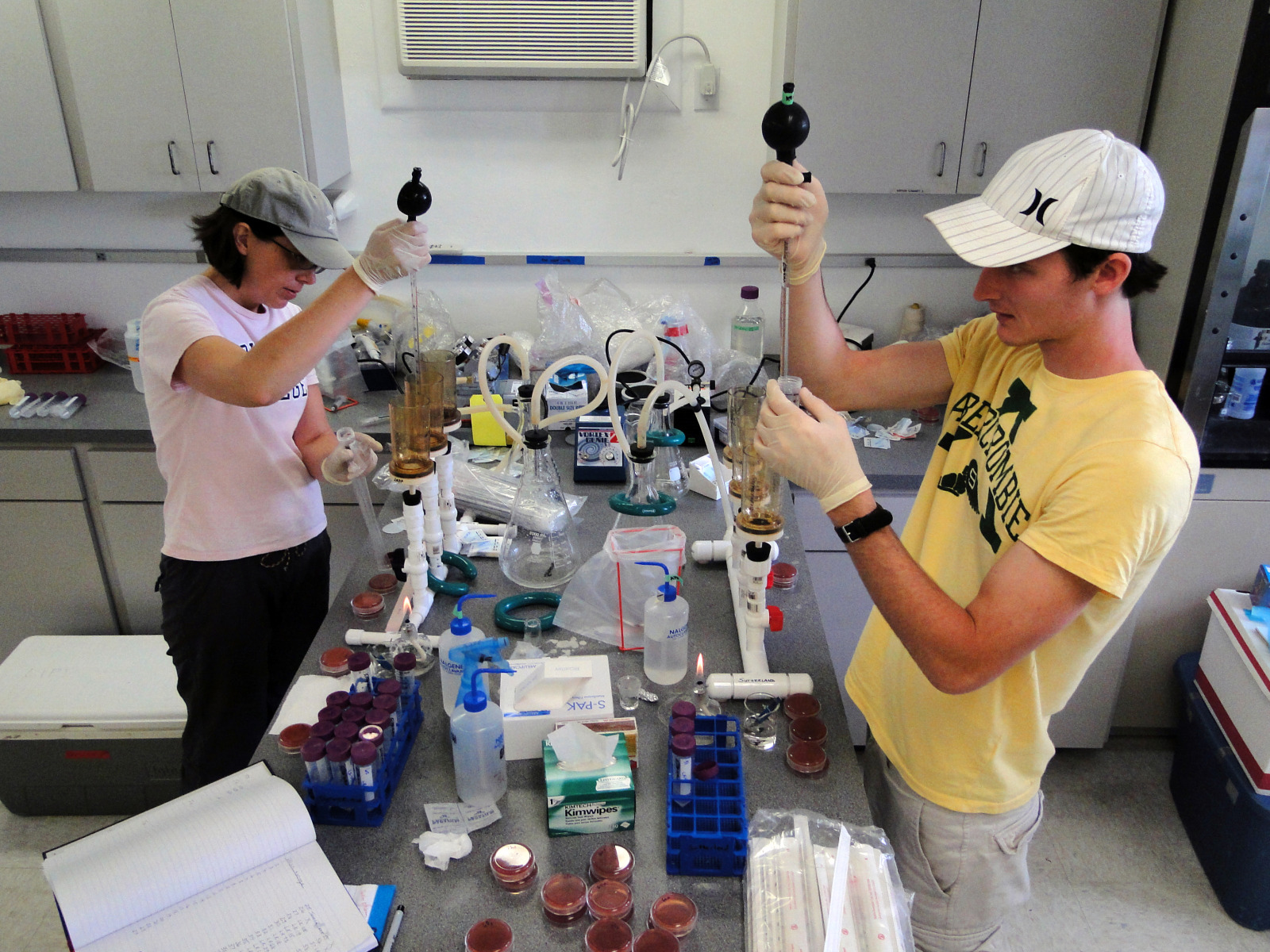 human sewage and the bacteria that live in our guts [what the bug does in us] It was the first time a disease has been found to jump from humans to a marine invertebrate:
human sewage and the bacteria that live in our guts [what the bug does in us] It was the first time a disease has been found to jump from humans to a marine invertebrate:
Kathryn - This is a different disease pathway than what we traditionally hear about human and wildlife, usually it's going from wildlife to humans. And example of a wildlife to human disease transmission model is swine flu or bird flu or HIV. But the movement of a disease-causing microbe from a human to a marine invertebrate had never been shown before.
Helen - And it's not just the bacteria in waste water that can cause problems for corals but the also nutrients - largely nitrates - that come with sewage.
Kathryn - When we add nutrients to the seawater where we find coral reefs we have algae blooms and macroalgae growth that outcompete corals for space on the reef and limit their ability to photosynthesise when we have we have algal growth in the water column"
Helen - Now that the cause of the disease has been identified, steps are being taken to combat the problem at the source.
Kathryn - We have bad news that humans are the source of the pathogen but the good news is that we have a solution. And the solution is actually already underway in the Florida Keys. And the solution is advanced waste water treatment. Historically in the Florida Keys they've utilised septic systems to contain human waste and the problem is that septic systems were not designed for areas like the Florida Keys.
These waste disposal systems were designed for rural areas with low population densities and areas with soil. Soil filters any contaminates that leak from a faulty septic system. But the Florida Keys are a high population density area with no soil and there's limestone bedrock instead. And this bedrock is porous and it allows human waste leaking from a faulty septic tank to quickly reach the groundwater and the nearshore environment.
A decade ago the city of Key West upgraded their sewage treatment from septic systems to advanced waste water treatment. And today the entire Florida Keys is the process of upgrading local waste water treatment and these measures will eliminate a source of the bacterium to the marine environment"
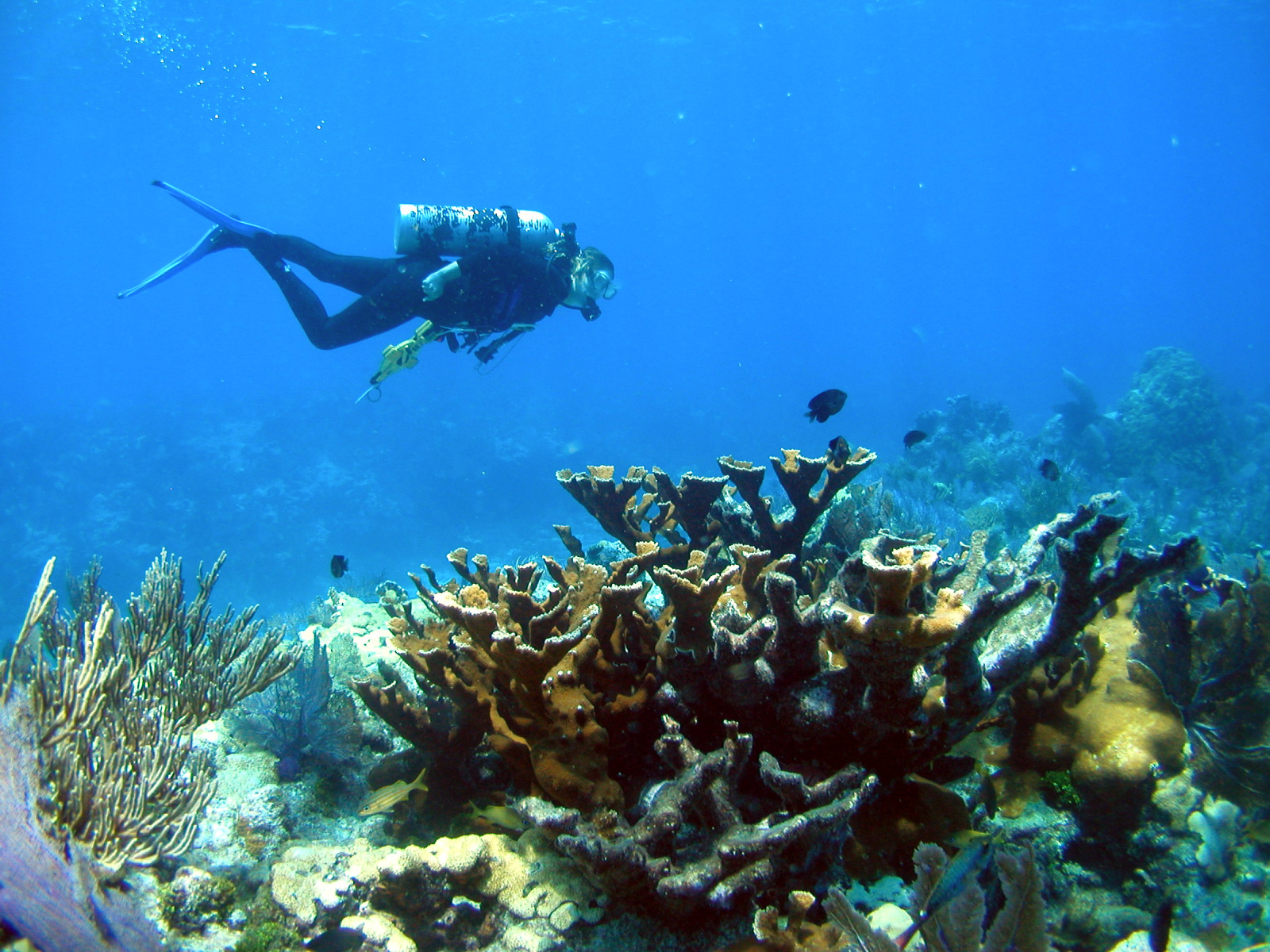 Helen - Well, white pox disease isn't just a problem in Florida but across the Caribbean where there the widespread lack of good waste water treatment means that reefs continue to be vulnerable to a human source of the disease. Another question is whether this same bacteria, that is common across the world, is causing problems for marine organisms beyond the western Atlantic.
Helen - Well, white pox disease isn't just a problem in Florida but across the Caribbean where there the widespread lack of good waste water treatment means that reefs continue to be vulnerable to a human source of the disease. Another question is whether this same bacteria, that is common across the world, is causing problems for marine organisms beyond the western Atlantic.
Kathryn - Serratia marcescens could be affecting corals elsewhere in the world or other microbes that are associated with human sewage. We've described approximately 20 coral diseases and we only know the causes of approximately five. So there's a lot of unknowns out there. And so Serratia marcescens may be affecting other corals and causing other disease signs, signs that look different from white pox and on different coral species.
Helen- With funding from the National Science Foundation Ecology of Infections Disease programme, Kathryn is collaborating on a 5-year study jointly with Rollins College and the University of Georgia to understand how the pathogen infects corals and what drives outbreaks of the disease on reefs - could it be factors like climate change and warming seas?
Kathryn - One thing we're really interested in is the entire microbial community associated with corals when they're diseases and when they're healthy. So we've been focussing on collecting mucous samples both for culture of the pathogen, to look for the presence of the pathogen, in diseased corals and in healthy corals. But we're also looking at this mucous layer for the whole microbial community and we're analysing the whole microbial DNA. And what we want to do is compare the microbial community present on the diseased corals to the microbes present on healthy corals.
As I mentioned the coral mucous layer and the microbes that reside in this mucous layer are the first line of defence of a coral against pathogens. And the microbes present in the layer when the coral is healthy may play a role in defence against the pathogen.
So we hypothesise that when the host coral is stressed or for example warmer seawater temperatures stress the coral, the microbial community present in the mucous layer may shift or change. And this change in the microbial community may facilitate infection. And one question we're trying to answer is when the microbial community changes does this permit the infection by Serratia marcescens or is it the arrival and the proliferation of SM in the mucous layer that changes the microbial community?
So which comes first? The arrival of the pathogen and then a shift in the microbial community? Or the shift in the microbial community that facilitates the pathogen?
Helen - The mystery of white pox disease may have been solved but there is still a lot we don't know about coral diseases, and many that still have not been fully diagnosed.
Kathryn - And so as we approach other coral diseases that are out there affecting the corals and lots of unknowns we just have to keep an open mind about what may be the cause. It might be a bacterium, or it might be a virus, or it might be a fungus. And so you have to just start one at a time and see where it goes.
Find out more:
Kathryn Sutherland, Rollins college.
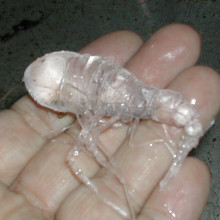
18:46 - Critter of the month – Cystisoma, the see-through deep sea shrimp
Critter of the month – Cystisoma, the see-through deep sea shrimp
with Jon Copley, University of Southampton
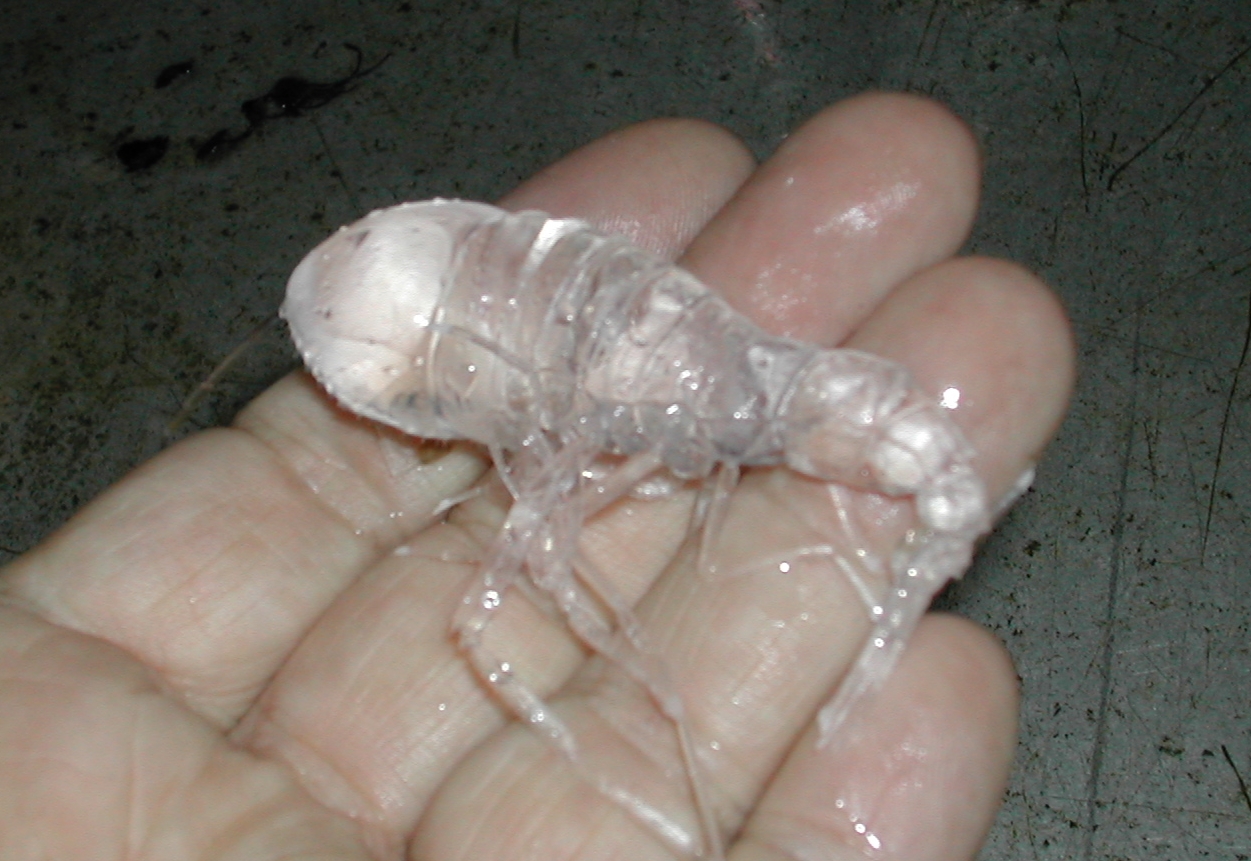 We ask Jon Copley from the University of Southampton to tell us if he was a marine creature, which one he'd be and why.
We ask Jon Copley from the University of Southampton to tell us if he was a marine creature, which one he'd be and why.
Jon -I'm Jon Copley, I'm a Marine Biologist at the University of Southhampton and asking a Marine Biologist to pick a marine critter who they would like to be is actually a really hard question because there are so many different life forms out there and they have such remarkable different adaptations, so it is very hard to choose. But, if I have to pick one critter I think I would like to be an animal called Cystisoma and that's a crustacean that lives in the deep sea and it's a type of animal called an amphipod. And what's unusual about is it's transparent. Its whole body is see-through, every tissue and organ is see through. It's like the invisible man and I think that is one of the most remarkable adaptations that I have come across in the deep sea.
So it lives down to about a thousand meters and that is what we call the twilight zone because some light actually reaches down to about a thousand meters in the clearest ocean water. But below about 200 - 300 meters it is very, very faint. In fact the water looks this incredible, luminous black; it's this deepest blue that you could possibly imagine. Because there is still light though getting down to about a thousand meters it means that animals living down in this twilight zone still cast shadows. So life down there is basically a perpetual game of hide and seek, all the animals are looking for the shadows of their prey above and they are all desperately trying not to cast shadows below them.
And so we get transparent animals, that is one way to avoid casting a shadow is to make your body completely transparent to turn into like the invisible man. And that's what Cystisoma does, these animals are shrimp like animals, they are about 4 inches long. I have held one in my hand when I was down in the Gulf of Mexico. They have a pair of enormous eyes, most of their head, which is about a third of their body is just a pair of eyes. So they are looking upwards, incredibly sensitive eyes looking for the shadow of any of their prey above. Then to make sure they don't cast any shadow they're completely see-through.
That is just remarkable. Think about all your body's organs, what would be required biologically to make all of those see-through and transparent, it's a phenomenal creature.
Find out more:
Jon Copley, NOC
Related Content
- Previous Ozone: Chemistry in its element
- Next The Science of Pain









Comments
Add a comment